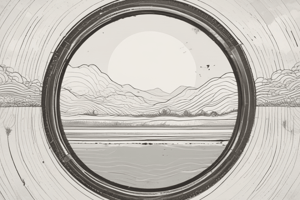Podcast
Questions and Answers
How often does El Niño typically occur?
How often does El Niño typically occur?
What is the primary effect of El Niño on the Walker Circulation?
What is the primary effect of El Niño on the Walker Circulation?
How does El Niño affect the Intertropical Convergence Zone (ITCZ)?
How does El Niño affect the Intertropical Convergence Zone (ITCZ)?
What is the primary cause of the increased rainfall on the west coast of South America during El Niño?
What is the primary cause of the increased rainfall on the west coast of South America during El Niño?
Signup and view all the answers
How does El Niño affect the Humboldt Current?
How does El Niño affect the Humboldt Current?
Signup and view all the answers
What is a consequence of the reduced upwelling of cold water during El Niño?
What is a consequence of the reduced upwelling of cold water during El Niño?
Signup and view all the answers
What is the primary effect of El Niño on Southeast Asia and Australia?
What is the primary effect of El Niño on Southeast Asia and Australia?
Signup and view all the answers
What is another name for El Niño?
What is another name for El Niño?
Signup and view all the answers
Study Notes
El Niño and the Walker Circulation
- The Walker Circulation describes the normal weather patterns in the Pacific Ocean between Southeast Asia and South America.
- In a normal year, the water near Indonesia is warm, and the water off the coast of South America is cold.
- This creates a high-pressure system off the coast of South America and a low-pressure system near Indonesia.
- The air pressure difference creates winds that blow from east to west.
El Niño
- El Niño occurs every 4-7 years, and it completely reverses the Walker Circulation.
- During El Niño, the high-pressure system moves to the west, and the low-pressure system forms off the coast of South America.
- The winds then blow from west to east.
- The water off the coast of South America warms, and the water near Indonesia and Australia cools, until the temperatures are similar.
- This pattern is also known as the El Niño Southern Oscillation (ENSO).
The Intertropical Convergence Zone (ITCZ)
- El Niño occurs when the ITCZ shifts further south than usual.
- The ITCZ is a band of low pressure around the equator.
- The trade winds converge in the ITCZ.
- The ITCZ shifts south during December and January due to the Earth's tilt.
- During El Niño, the ITCZ moves further south between December and February.
- The exact reason for the ITCZ shifting further south during El Niño is unknown.
El Niño Effects on South America
- The shift in the ITCZ during El Niño weakens the Southeast Trade Winds.
- The weaker winds reduce the upwelling of cold, nutrient-rich water from the depths of the ocean.
- The Humboldt Current weakens, which brings cold water up from the depths to the surface.
- The lack of cold water leads to a decrease in the amount of plankton available for fish.
- The warmer ocean temperatures also warm the air above it.
- This causes a low-pressure system to develop over South America.
- The warm, moist air rises and condenses, leading to heavy rainfall on the normally dry west coast of South America.
- The heavy rainfall can cause floods.
El Niño Effects on Southeast Asia and Australia
- The lack of warm water flowing towards the west creates a high-pressure system over Southeast Asia and Australia.
- The high pressure causes dry conditions and droughts in those regions.
- The dry conditions can negatively affect agriculture and lead to crop failures in countries like Australia.
El Niño Impacts on People
- Fishers on the west coast of South America are negatively affected by El Niño due to the decrease in fish populations.
- Farmers in northern Australia are also harmed by El Niño's dry conditions and crop failures.
Studying That Suits You
Use AI to generate personalized quizzes and flashcards to suit your learning preferences.
Description
Test your knowledge on El Niño and the Walker Circulation with this quiz. Explore how these phenomena impact weather patterns in the Pacific Ocean and learn about the effects of the Intertropical Convergence Zone (ITCZ). Challenge yourself with questions about their years of occurrence and the shifts in pressure systems.



